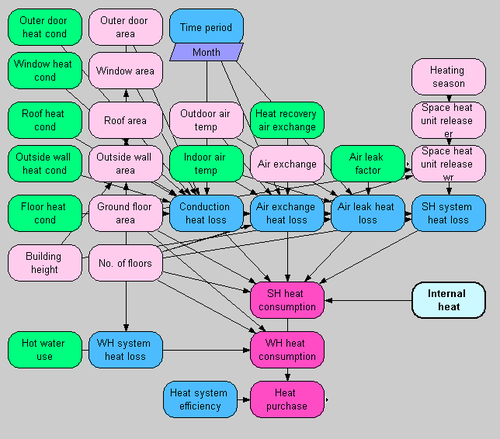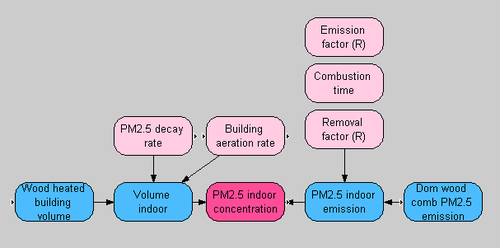CLAIH assessment
| Moderator:Virpi Kollanus (see all) |
|
|
| Upload data
|
Climate change, air quality and housing – future challenges to public health (CLAIH)
Scope
Purpose
The purpose of the assessment is to evaluate the health impacts and costs in Finland in the future if different housing policies are undertaken.
More specifically:
- What would be the health impacts and costs in Finland in 2030 if the society preferred different residential building heating systems and building energy efficiency solutions and fuels and forms for district heat production?
- What would be optimal combinations of residential building heating systems, building energy efficiency and fuels and forms of district heating?
- What would be the amount of societal subsidies needed to ensure the transition to the preferred heating systems and energy efficiency in housing?
Preferences for different decisions on residential building heating and energy efficiency solutions are assessed from the perspective of a citizen. Total health impacts and all other societal costs (total costs to all citizens, costs from CO2emissions etc.) from different decision options are assessed from the perspective of the whole Finnish society, and the optimal distribution of societal subsidies for different heating system and energy efficiency solutions are evaluated based on the total costs.
Boundaries
- Population: Finland
- Assessment time frame: 2010-2030
- Evaluated activity: heat production and consumption in residential building stock (detached houses, row houses, apartment buildings)
- Evaluated exposures:
- Fine particles (PM2.5)
- Outdoor concentrations
- Indoor concentrations from domestic wood combustion
- Personal exposure
- Indoor dampness and mold
- Indoor Radon
- Indoor air temperatures?
- Fine particles (PM2.5)
- Evaluated health impacts:
- Mortality and morbidity due to long term exposure to PM2.5
- Asthma incidence due to long term exposure to PM2.5
- Asthma due to indoor mold and dampness
- Lung cancer due to indoor radon
- Other evaluated emissions: CO2
- Evaluated costs:
- Costs fron health impacts
- Costs from building stock heat production and consumption
- Costs from building stock heating system/energy efficiency renovations
- Costs from energy infrastructure changes (District heat production development)
- Costs from CO2 emissions
- Decisions to be evaluated relate to:
- Fuel options for district heating (for both large existing CHP plants and small scale district heat production)
- Form of district heat production (should there be more small scale district heat production?)
- Household heating system options
- Building energy efficiency improvement options
- Building air filtering
Underlying scenarios
- Climate change (temperature) scenarios based on IPCC
- A2 (heterogeneous world, rising population, slow technological change)
- A1B (rapid growth of world economy and population, advent new and more efficient technologies, balanced use of fossil and renewable energy sources)
- B1 (rapid development towards environmentally friendly technologies)
- Greenhouse gas emission reduction scenarios
Intended users
- Ministry of Employment and the Economy
- Ministry of Social Affairs and Health
- Ministry of the Environment
- Any interested party
Participants
- FMI
- University of Oulu
- THL
- Anyone interested
Definition
Decisions to be evaluated
Society:
- Fuel for district heat production (natural gas, coal, wood, peat, oil, geothermal heat)
- Form of district heat production (should there be more small scale district heat production?)
- Subsidies for household heating system/energy efficiency renovations
- Demands/subsidies for new building stock heating systems/energy efficiency
- Demands/subsidies for building air filters
Citizen:
- Household heating system renovations
- Building energy efficiency renovations
Building stock development

- Heating systems in buildings in Finland
- Energy efficiency of buildings in Finland
- Heating system renovations in house stock in Finland
- Energy efficiency renovations in house stock in Finland
- New house stock production in Finland
Building heat consumption

Emissions
- PM2.5 emissions from house stock heating in Finland
- Emission factors for burning processes
- CO2 emissions from house stock heating in Finland
- CH4 emissions from house stock heating in Finland
- N2O emissions from house stock heating in Finland
Exposure and exposure-response functions
PM2.5

Outdoor air concentration
Indoor air concentration
- PM infiltration from outdoor air to indoor air
- PM2.5 concentration indoors from indoor sources in Finland
Personal exposure
ERFs
- ERF of PM2.5 on mortality in general population
- ERF for short-term PM10 exposure and cardiovascular hospital admissions
- ERF for short term PM10 exposure and respiratory hospital admissions
- ERF for short term PM2.5 exposure and restricted activity days (RADs)
- ERF for short term PM2.5 exposure and work loss days (WLDs)
- ERF for short term PM2.5 exposure and minor restricted activity days (MRADs)
- ERF for short term PM10 exposure and medication usage by people with asthma
- ERF for short term PM10 exposure and lower respiratory symptoms (LRS)
Indoor dampness and mold
- Exposure to dampness and mold contamination in homes in Finland
- ERF for respiratory health effects of dampness and mold contamination in homes
- Asthma prevalence in Finland
Indoor radon
- Radon indoor air concentration in Finland
- ERF for long-term indoor exposure to radon and lung cancer
Heat
- Outdoor air temperature in Finland
- ERF of ambient temperature on mortality
- ERF for heat exposure and morbidity
- ERF for cold exposure and mortality
Health impacts

Health impact indicators
Calculated for all exposures:
- Attributable mortality and morbidity
- Loss of disability adjusted life years (DALY)
- Years of life lost due to mortality (YLL)
- Years of life lost due to morbidity (YLD)
- Loss of life-expectancy
Background information needs
Costs
Citizen:
- Heat system/energy efficiency renovation investment
- Cost from household heating
Society
- Costs from healt impacts
- Value of a statistical life (VSL)
- Value of a life year (VOLY)
- Discount rate for health effects
- Unit value of hospital admissions
- Unit value of restricted activity days (RADs)
- Unit value of work loss days (WLDs)
- Unit value of minor restricted activity days (MRADs)
- Unit value of chronic bronchitis
- Unit value of respiratory medication use
- Unit value of respiratory symptoms in asthmatics
- Unit value of cough days
- Costs from CO2 emissions
- Costs to citizens
Analyses
- Cost-effictiveness analysis
- Cost-benefit analysis
- Value-of-information analysis
Result
Result
The preliminary results are based on the following assumptions:
Building stock:
- Annual building stock loss is 0.6%. Only buildings older than 50 years are pulled down.
- Annual new building stock construction determined by the annual building stock loss 0.6%) and annual increase in the residential surface area per person (0.7%)
- All new buildings are current standard in energy efficiency.
- Fraction of heating systems in new buildings is the same as in the buildings constructed between 2000-2010.
- No heating system/energy efficiency renovations are done in the current building stock.
- Energy efficiency of buildings constructed at different decades is based on the building restrictions at the construction time.
Energy production/consumption:
- District heat production:
- 75% in large CHP plants, 25% in small scale heat production plants
- Fraction of used fuels is based on the year 2008.
- These are assumed to stay the same in the future.
- Electricity production is based on the year 2008. This is assumed to stay the same in the future.
- Only primary heating systems in the residential buildings are included in the assessment.
- Fraction of the combustion techniques used in the domestic wood heating is based on information from the year 2000 (FRESH model).
PM2.5 exposure
- Only emissions to outdoor air are included in the assessment.
- PM2.5 emission intake fraction for domestic combustion is based on the PILTTI project.
- PM2.5 emission intake fraction for large and small power plants are based on KOPRA project.
- Exposure-response function (RR) for PM2.5 exposure and natural mortality is based on the Tuomisto et al. 2008 expert eliciation study (0.97% (90% Cl 0.02-4.54) per 1 µg/m3 increase in PM2.5.
Mold and dampness exposure
- Prevalence of mold and dampness exposure in Finnish residences is 15%
- Exposure-response function for mold and dampness exposure and current asthma is all age groups is 1.56 (1.30–1.86) (Odds ratios for asthma in homes with vs. without visible dampness and/or mold or mold odor)
- Asthma prevalence in Finnish population is 8% (assumed to be the same in all age groups)
Radon exposure
- Average radon concentration in Finnish residences is 120 Bq/m3.
- Exposure-response function (RR) for radon exposure in home and lung cancer mortality is 1.16 (95 % CI 1.05 - 1.31) per 100 Bq/m3.
Results:
Conclusions
See also
- Assessment of building policies' effect on dampness and asthma in Europe
- Housing data sources
- HI:Policy for PM2.5 Exposure
- Mega case study
- Assessment on impacts of emission trading on city-level (ET-CL)
- Bioher (project) and the Bioher assessment
- IPCC Special Report: Emission Scenarios
- ISAAC cohort
- FINRISK cohort
- ERA17 – Energiaviisaan rakennetun ympäristön aika 2017 -toimintaohjelma
- Vehviläinen et al. 2010. Rakennetun ympäristön energiankäyttö ja kasvihuonekaasupäästöt
- Pesola et al. 2011. Energiaskenaarioiden järjestelmävaikutukset rakennuskantaan
- Vanhanen et al 2010. Energiaskenaarioiden järjestelmävaikutukset ja niiden taloudelliset, ympäristölliset ja yhteiskunnalliset seuraukset
- Motiva 2009. Pientalon lämmitysjärjestelmät
- Kouhia et al. 2010. Rakennuksen ulkovaipan energiakorjaukset
